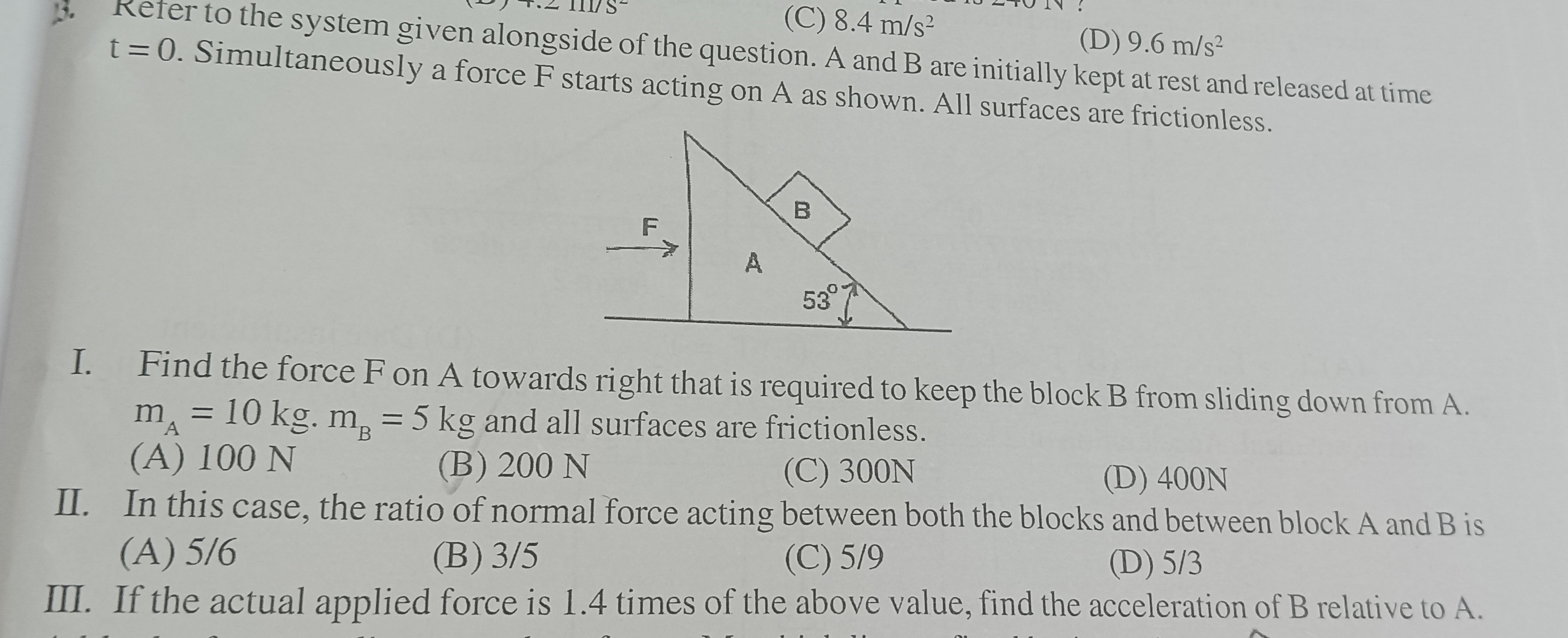Question
Question: Refer to the system given alongside of the question. A and B are initially kept at rest and released...
Refer to the system given alongside of the question. A and B are initially kept at rest and released at time t = 0. Simultaneously a force F starts acting on A as shown. All surfaces are frictionless.
I. Find the force F on A towards right that is required to keep the block B from sliding down from A. mA=10kg, mB=5kg and all surfaces are frictionless.
II. In this case, the ratio of normal force acting between both the blocks and between block A and B is
III. If the actual applied force is 1.4 times of the above value, find the acceleration of B relative to A.

100 N
200 N
300N
400N
I. (B), II. (C), III. 16 m/s^2
Solution
The problem involves analyzing the motion of a block on an inclined plane which is itself free to move. The surfaces are frictionless. We will use Newton's laws of motion in an inertial frame of reference (ground frame).
Let mA=10 kg and mB=5 kg. The angle of inclination is θ=53∘. We can use sin53∘≈0.8 and cos53∘≈0.6, and tan53∘=cos53∘sin53∘≈0.60.8=34. Let g=10 m/s2.
Part I: Find the force F on A towards right that is required to keep the block B from sliding down from A.
When block B does not slide down from A, it means that block B is at rest relative to A. Thus, block B moves with the same acceleration as block A. Let the horizontal acceleration of A and B be a to the right.
Consider the forces on block B in the inertial frame:
- Gravity mBg downwards.
- Normal force NAB from A on B, perpendicular to the inclined surface.
Resolve the forces on B into horizontal and vertical components. The normal force NAB makes an angle θ with the vertical.
Horizontal equation of motion for B: NABsinθ=mBa
Vertical equation of motion for B: NABcosθ−mBg=0 (since vertical acceleration of B is 0)
From the vertical equation: NAB=cosθmBg.
Substitute this into the horizontal equation: (cosθmBg)sinθ=mBa⟹a=gtanθ.
Now consider the system of A and B together. The total mass is mA+mB. The external horizontal force is F.
Horizontal equation of motion for the system: F=(mA+mB)a.
Substitute the expression for a: F=(mA+mB)gtanθ.
Using the given values: mA=10 kg, mB=5 kg, g=10 m/s2, tan53∘=4/3.
F=(10+5)×10×34=15×10×34=5×10×4=200 N.
Part II: In this case, the ratio of normal force acting between both the blocks and between block A and the ground is
The normal force between the blocks is NAB=cosθmBg.
The normal force between block A and the ground, Nground, can be found by considering the vertical equilibrium of the system (A+B). The total downward force is (mA+mB)g, and the upward force is Nground. Thus, Nground=(mA+mB)g.
The ratio is NgroundNAB=(mA+mB)gcosθmBg=(mA+mB)cosθmB.
Using the given values: mB=5 kg, mA=10 kg, cos53∘=0.6.
Ratio = (10+5)×0.65=15×0.65=95.
Part III: If the actual applied force is 1.4 times of the above value, find the acceleration of B relative to A.
The force found in part I is F0=200 N. The actual applied force is F=1.4×F0=1.4×200=280 N.
Since the applied force is greater than F0, block B will slide up relative to A.
Let's recheck the formula for aB/A.
aB/A=(mA+mB)sin2θ−mAcos2θFcosθ−(mA+mB)gsinθ
Using values:
Numerator: 280×0.6−(10+5)×10×0.8=168−120=48.
Denominator: (10+5)×(0.8)2−10×(0.6)2=15×0.64−10×0.36=9.6−3.6=6.
aB/A=648=8 m/s2.
The final answer is I.(B),II.(C),III.16m/s2.
